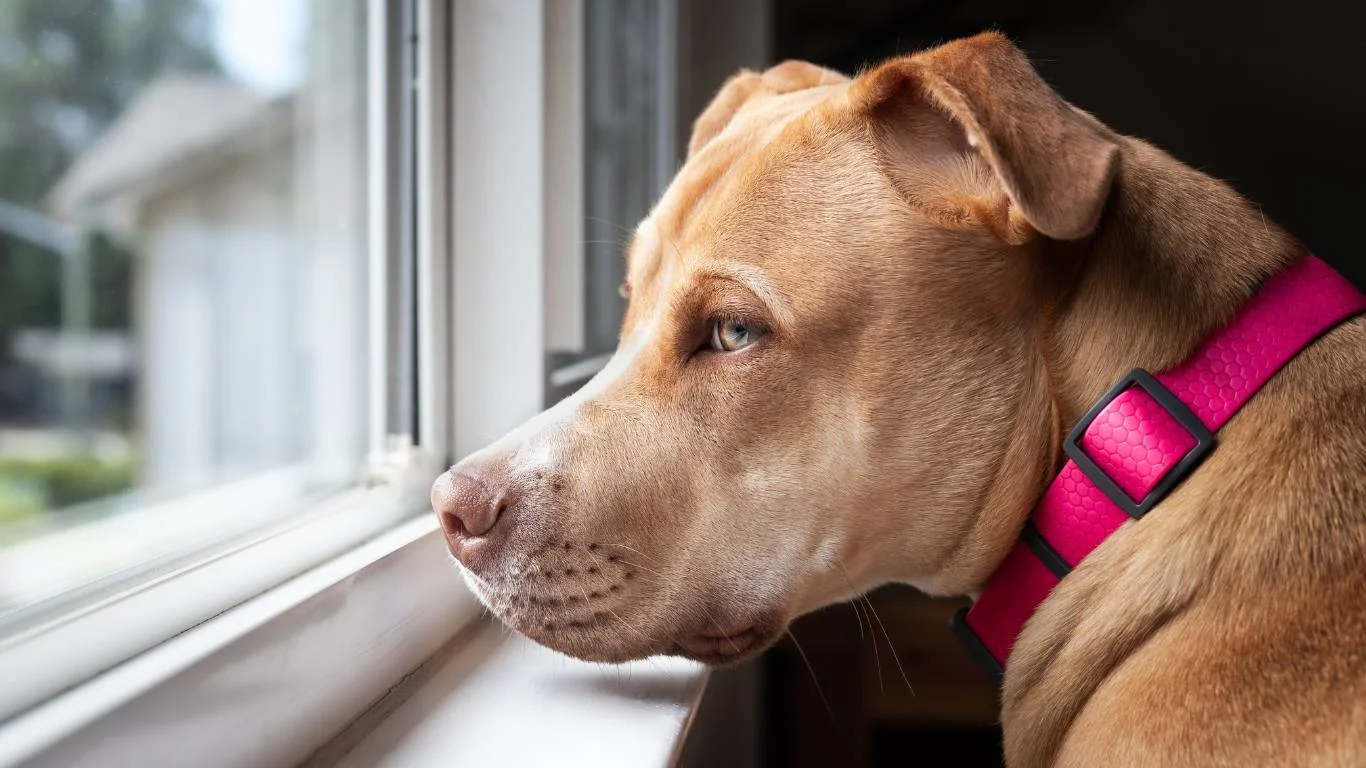How to Calm a Dog with a Nervous Stomach: Proven Soothing Tips That Work
If you’re searching for how to calm a dog with a nervous stomach, you’re probably dealing with a pup who’s pacing, panting, or refusing to eat. I’ve seen it countless times during my time as a veterinary assistant, especially with dogs who have sensitive digestive systems or who are easily stressed. Whether it’s car rides, separation anxiety, or even thunderstorms, tummy troubles can flare up fast. And as a pet parent, it’s hard not to feel helpless watching them suffer. Let’s talk about some real-world strategies and holistic approaches that can actually make a difference — straight from my experience in the vet clinic and my time working one-on-one with pet owners who were just like you.
Understanding the Nervous Stomach in Dogs

What Is a Nervous Stomach in Dogs?
First off, a “nervous stomach” isn’t an official diagnosis, but it’s a phrase we hear all the time at the clinic. It usually means your dog’s digestive issues are triggered by stress, anxiety, or sudden changes. Think of it like how some of us get an upset stomach before a big presentation — dogs are no different. Symptoms often include:
- Loss of appetite
- Vomiting or occasional regurgitation
- Soft or loose stools (sometimes with mucus)
- Excessive drooling or lip licking
- Pacing or restlessness, especially at night
I’ve had clients rush in thinking their dog had a major illness, and while it’s always wise to rule out serious conditions, sometimes it’s just stress that’s throwing off their gut.
Why Stress Hits the Stomach So Hard
The gut-brain connection in dogs is super real. The gastrointestinal tract has its own network of nerves — the enteric nervous system — which communicates constantly with the brain. When your dog feels anxious, their body releases stress hormones like cortisol, which can slow digestion or cause inflammation. That’s when you start seeing all the not-so-fun symptoms.
From what I’ve seen, some dogs are just hardwired to be more sensitive. I remember working with a young Vizsla named Rudy. His stomach would go haywire every time his owners went on vacation, even if he was left with someone he knew. We had to get creative with his care plan — more on that later — but it just shows how individual this stuff can be.
Common Triggers That Upset Your Dog’s Stomach

Environmental Stressors
Changes in routine, new places, loud noises, or even guests in the house can send some dogs into a spiral. I’ve seen pups go from perfectly healthy to throwing up their kibble just because of a fireworks show. And it’s not always the big things — even something as simple as moving their food bowl to a different spot can trigger anxiety in particularly sensitive dogs.
Dietary Changes
Switching food too quickly? Yep, major culprit. Even adding new treats or table scraps can disrupt their digestion. One Labrador I worked with, Bruno, had a super delicate gut. His owner gave him a bite of spicy sausage (just one bite!) and we were dealing with watery stools and nausea for days. If your pup has a nervous stomach, slow transitions and consistency are your best friends.
Separation Anxiety
This one’s huge. Dogs who hate being alone often show it through their stomachs. I’ve known dogs who would literally vomit every time their owners left for work. In cases like these, calming the gut means addressing the emotional side too — and yes, it can be done gently, without sedatives.
Overexcitement or Physical Overexertion
You wouldn’t think excitement could mess with a dog’s gut, but it can. A few times in the clinic, I’ve treated dogs who got so amped up during playdates or hikes that they ended up with vomiting or diarrhea later. It’s all part of that gut-brain loop again. Knowing your dog’s limits — both emotional and physical — is key to preventing those upset tummies.
How to Calm a Dog with a Nervous Stomach: Foundational Steps

Step 1: Start With the Gut – Nutrition First
This is where I light up, because nutrition is my jam. The gut is ground zero for so many health issues, and calming it down often starts with what’s going in. For nervous-stomach dogs, I recommend:
- Highly digestible diets: Think bland, simple ingredients. White rice and boiled chicken or vet-approved GI formulas are great in the short term.
- Probiotics: These are a game-changer. A daily probiotic can help stabilize gut flora and reduce inflammation. I’ve seen incredible turnarounds in just a few days.
- Consistent feeding schedule: Feed at the same times each day to give your dog’s digestive system a routine it can depend on.
I had a pup named Tilly, a rescue with major anxiety, who used to vomit bile every morning. Once we switched her to a vet-recommended gastrointestinal diet and gave her a steady morning feeding time, the vomiting stopped almost completely.
Step 2: Create a Calm Feeding Environment
Sometimes the problem isn’t what your dog is eating — it’s how and where they’re eating. Make mealtime peaceful. Feed in a quiet space away from high-traffic areas, kids, or other pets. Use a slow feeder bowl if they gulp their food down too quickly. If your dog is a picky eater because of anxiety, warming the food slightly or adding a low-sodium bone broth can make it more appealing without upsetting their tummy.
Natural Remedies That Soothe a Nervous Stomach

Herbal Helpers
Now, I’m not saying your pup needs a trip to the apothecary, but there are actually some gentle herbs that can work wonders for calming a nervous stomach. I’ve recommended these time and again to pet parents at the clinic, and with the right vet guidance, they can be part of a holistic care plan.
- Chamomile: Yep, the same one we humans use to chill out. Chamomile tea (cooled, of course) can be drizzled over food in small amounts or given as part of a calming chew. It helps with nausea, gas, and overall nervous tension.
- Ginger: A teeny pinch of ginger (grated fresh or in powder form) can help settle the tummy, especially for dogs prone to car sickness or motion-related anxiety. Just avoid giving too much—it’s powerful stuff!
- Slippery elm: This one’s a lesser-known hero. It coats the stomach lining and can ease inflammation. I’ve seen it help dogs who had both anxiety and loose stools from mild GI irritation.
Of course, always double-check with your vet before trying herbal remedies, especially if your dog’s on meds or has other health issues. Safety first, always.
Calming Supplements and Chews
Another option that many of my clients have had success with? Calming chews. There are so many on the market now, it can feel overwhelming. Look for ingredients like:
- L-theanine and L-tryptophan: Amino acids that help promote relaxation and reduce cortisol spikes.
- Melatonin: Useful for evening anxiety or nighttime restlessness. I’ve seen this help dogs who get upset stomachs overnight.
- CBD (with vet approval): Some dogs really respond well to full-spectrum hemp oil. Just make sure it’s high quality and THC-free.
I had one older Lab named Daisy who had separation anxiety so bad, she’d get sick every time her human left the house. With a mix of calming chews and a consistent departure routine, we saw huge improvement in both her behavior and her digestion.
Behavioral Tools for Long-Term Gut Health

Routine and Predictability
If there’s one thing dogs crave when they’re feeling anxious, it’s predictability. Nervous stomachs often flare up when things feel chaotic, so creating a daily rhythm can make a world of difference. Try to:
- Keep feeding times consistent
- Go for walks around the same times each day
- Stick to familiar routes and people
- Establish calming rituals before bed or when leaving the house
It doesn’t have to be rigid, but predictability builds trust. One Border Collie I worked with, Luna, had her stomach turn every time her routine got thrown off. Once her owner created a simple, stable structure for meals and playtime, Luna’s gut calmed down significantly. It wasn’t magic—it was just consistency.
Crate Training for Comfort, Not Confinement
Used correctly, a crate can be a safe haven for an anxious dog. I’ve seen so many pups benefit from having a space that’s 100% theirs—no stress, no chaos. When dogs associate their crate with calm, it can help regulate their nervous system and, you guessed it, reduce those tummy issues.
Make it cozy. Add a soft blanket, a favorite toy, maybe even a lightly worn shirt of yours for scent comfort. Don’t use the crate for punishment—ever. It’s about building security, not control.
Desensitization and Counterconditioning
Now we’re diving a bit deeper into the behavioral side. If your dog’s nervous stomach is triggered by specific situations—like car rides, vet visits, or even seeing the suitcase come out—it’s worth doing some desensitization work.
Start small and reward calm behavior. For example, if car rides make your dog anxious, begin by just sitting in the parked car with them and giving treats. Gradually work up to turning the car on, then short drives, always associating the experience with something positive. Over time, the stress (and the digestive issues tied to it) can fade.
When to Talk to Your Vet About Digestive Anxiety

Red Flags You Shouldn’t Ignore
Even though many cases of nervous stomachs in dogs are tied to stress, it’s super important to rule out more serious problems. I’ve seen well-meaning owners assume it’s “just anxiety” when it was actually pancreatitis or a food allergy. Be on the lookout for:
- Persistent vomiting or diarrhea (lasting more than 24–48 hours)
- Blood in vomit or stool
- Lethargy or signs of pain
- Sudden weight loss
- Loss of appetite for multiple days
These symptoms deserve a vet visit, pronto. And yes, even mild cases should be discussed with your vet if they’re happening frequently. Chronic gut issues can wear your dog down over time and may require prescription diets or further diagnostics like fecal testing, bloodwork, or even imaging.
Diagnostic Tools Your Vet Might Use
If your vet suspects there’s more going on than just nerves, here’s what they might do:
- Fecal exam: To rule out parasites or abnormal bacteria
- Blood tests: Checking organ function, inflammation, and overall health
- X-rays or ultrasound: To see if there’s any blockage, gas buildup, or other physical issues
- Food trial: A common approach if allergies or sensitivities are suspected
In my experience, many dogs with “nervous stomachs” actually have a combo of emotional and physical factors at play. Addressing both—behavior and diet—is usually the best route for long-term relief.
Training Techniques That Support Digestive Calm

Teach Calmness as a Skill
One of the most overlooked ways to ease a dog’s nervous stomach is through training that builds emotional regulation. I’ve worked with so many clients who thought obedience was all about “sit” and “stay.” But teaching your dog how to relax? That’s a whole different level — and it can help settle their stomach too.
Try incorporating “place” training into your routine. It’s a command that teaches your dog to go to a specific spot (like a bed or mat) and stay there calmly. When done right, it gives anxious pups a task and a sense of control. I had a sweet little Cocker Spaniel named Benny who would shake and vomit when guests came over. With consistent “place” training, we created a safe routine that eventually kept his stomach—and nerves—much more steady.
Reward Calm Behaviors (Not Just Tricks)
This one’s a game-changer. Don’t just reward tricks — reward calmness. If your pup is lying quietly, chewing a toy, or observing the world without barking or jumping, mark that behavior with praise or a treat. You’re telling them, “Hey, being chill is awesome!” Over time, this kind of positive reinforcement teaches their brain (and digestive system) to stay more regulated during stressful moments.
Be Mindful of Your Own Energy
This might sound woo-woo, but trust me — dogs pick up on your stress. I can’t count how many times I saw dogs in the clinic mirror their humans’ anxiety. One Yorkie literally started trembling every time her owner walked in the exam room. As soon as the owner began doing breathing exercises and using a calmer tone, the dog’s symptoms became noticeably less intense. Your energy matters more than you think.
Emergency Tips for Soothing a Flare-Up

Short-Term Soothing Strategies
Okay, so let’s say your dog is in the middle of an upset stomach episode — pacing, refusing food, maybe even throwing up. First off, don’t panic. Here are some things I’ve personally used or recommended that can help calm things down quickly:
- Skip a meal or two (temporarily): Let the stomach rest. For healthy adult dogs, fasting for 12–24 hours (water only) can help reset things.
- Offer a bland meal: A small portion of boiled chicken and white rice is classic. It’s easy on the tummy and often well-tolerated.
- Keep them hydrated: Add a little low-sodium bone broth to their water or offer ice cubes if they won’t drink.
- Use a warm compress: A gently warmed rice sock or heating pad wrapped in a towel can soothe stomach discomfort.
- Minimize stimulation: Create a quiet space, dim the lights, and limit noise or movement. Calm vibes help.
Products I’ve Seen Work in a Pinch
Over the years, I’ve seen a few go-to products that tend to provide short-term relief. Not every dog reacts the same way, but it’s worth keeping a few of these in your toolkit:
- FortiFlora by Purina: A vet-recommended probiotic that’s super easy to sprinkle over food.
- Doggy Tummy Drops: These often have ginger and chamomile and can settle mild nausea fast.
- Thundershirt: Not food-related, but reducing anxiety physically can help stop digestive distress before it starts.
Always check labels and consult with your vet first, especially if your dog is on any meds or has known sensitivities.
Final Thoughts: Helping Your Pup Feel Safe From the Inside Out
The Gut-Brain Bond Is Powerful
It’s wild how closely connected the digestive system and nervous system are — not just in humans, but in our dogs too. By now, you’ve probably picked up on the theme: if you want to learn how to calm a dog with a nervous stomach, it’s not just about the food. It’s about reducing emotional stress, creating routines, and being your dog’s safe place. It’s about tuning in.
What Has Worked for Me and My Clients
I’ve seen dozens of nervous tummies over the years, and while every dog is unique, the most successful cases usually combine:
- Consistent, digestible diets
- Proactive stress management (training, supplements, environment)
- Understanding the dog’s triggers and working around them
- Regular communication with a trusted vet
And hey — don’t beat yourself up if you haven’t cracked the code yet. You’re trying. You’re reading. You care. That alone makes you the kind of dog parent your pup needs.
Helpful Resources and Continued Reading
- American Kennel Club (AKC) – Great for breed-specific anxiety tendencies
- PetMD – Reliable veterinary health insights
- National Institutes of Health (NIH) – Scientific info on the gut-brain connection
- Health.com – Human-animal bond and stress-related behavior studies
Disclaimer
This article is for informational purposes only and does not substitute for professional veterinary advice. If your dog is experiencing ongoing or severe symptoms, always consult with your veterinarian or a qualified animal health professional.






